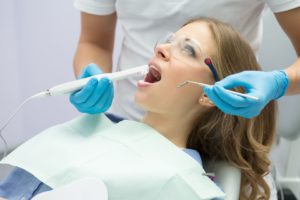
Dentistry has come a long way in recent decades thanks to advancements in technology, materials, and techniques. This is great for patients because recent innovations have led to enhanced comfort, faster diagnoses, and more accurate results. One popular invention that many dentists have adopted is the intraoral camera. If you’ve noticed that your provider has recently made the switch to this upgraded imaging device, continue reading to learn more about it!
What is an Intraoral Camera?
Essentially, an intraoral camera is a small instrument that allows your dentist to view the difficult-to-reach areas in your mouth. It’s a thin, cylindrical appliance that looks like a writing pen and is small enough to fit into spaces that are hard to see with the naked eye. It doesn’t cause any pain or discomfort and has no side effects. It’s simply an updated way for your dentist to get a clearer picture of what’s happening with your teeth and gums.
How Do Intraoral Cameras Work?
This thin tube is slightly longer than a pen and has a little lens fitted over the tip. It’s connected to your dentist’s computer to capture high-quality images as they move it around the inside of your mouth. The results can be projected onto their computer screen so that both you and your provider can see what’s happening in real-time. Then, any important views can be captured if they need to be examined in more depth.
What are the Benefits of Intraoral Cameras?
Intraoral cameras first arrived on the scene about 25 years ago and have now become an integral part of many dental practices because of the advantages they provide. Some of the benefits of using them include:
- Early detection. It’s possible to have cavities or gum disease in areas that are hard to see, like behind your back molars. This device is small enough to view those spaces to identify any areas of concern before they can progress.
- Improved accuracy. These cameras include features like a head that can rotate 90 degrees and LED lighting for improved visibility. Plus, they have powerful magnifying abilities and can zoom up to 100x or higher. This helps them see things that are often hard to find, like pulp exposures and vertical fractures, to provide more accurate diagnoses for appropriate treatment recommendations.
- Enhanced documentation. Instead of relying on lengthy written explanations of dental problems for your file, now your provider can include specific pictures. This helps document the original issue and the corrective measures taken, should they need to refer to it later.
- Better insurance claims. Dental insurance companies are more likely to cover claims that include images as proof of the dilemma and the required solutions. Having pictures and videos immediately available also saves a lot of time and hassle.
Now that you know more about why your dentist switched to using intraoral cameras, you can look forward to seeing the results at your next appointment!
About the Author
Dr. Michael McCleaster is dedicated to providing patients with a full range of dental services using state-of-the-art technology, including intraoral cameras. He first attended the College of New Jersey for his undergraduate education and then eventually earned his DMD degree from the University of Medicine & Dentistry of New Jersey. Since then, he has completed training in many different areas including implants, orthodontics, restorations, and cosmetic procedures. He stays on top of the most recent advancements in tools and techniques, so you know you’re getting top-quality service. If you’d like an appointment, you’re welcome to request one on the website or by calling (973) 598-0800.
